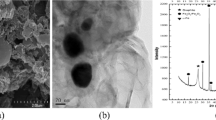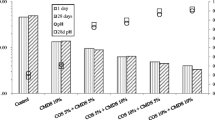Abstract
As and Pb-contaminated sediment obtained from the Nakdong Lake and Yeongsan River in the Republic of Korea was stabilized using a combination of calcined oyster shell (COS), waste cow bone (WCB) and coal mine drainage sludge (CMDS). The effectiveness of the stabilization treatment was evaluated using the Korean Standard Test (KST). The KST tests were performed using 1 N HCl extraction fluid for As and 0.1 N HCl extraction fluid for Pb. Scanning electron microscopy–energy dispersive X-ray spectroscopy (SEM–EDX) analyses were performed to investigate the mechanism responsible for As and Pb immobilization upon treatment. The treatment results showed that effective stabilization of As and Pb-contaminated sediment was obtained. Specifically, 10 wt% COS–5 wt% CMDS was the best treatment for As immobilization and 5 wt% COS–5 wt% WCB was the best treatment for Pb immobilization. The COS–WCB treatment outperformed the COS–CMDS treatment in immobilizing Pb in the contaminated sediment. SEM–EDX results indicated that Pb immobilization was strongly associated with Ca, Si, Al and P while As immobilization was strongly associated with Fe and O. Therefore, utilization of COS, WCB and CMDS is beneficial for the stabilization of contaminated sediment.





Similar content being viewed by others
References
Ahmad M, Hashimoto Y, Moon DH, Lee SS, Ok YS (2012) Immobilization of lead in a Korean military shooting range soil using eggshell waste: an integrated mechanistic approach. J Hazard Mater 209–210:392–401
Akhter H, Cartledge FK, Roy A, Tittlebaum ME (1997) Solidification/stabilization of arsenic salts: effects of long cure times. J Hazard Mater 52:247–264
An B, Zhao D (2012) Immobilization of As(III) in soil and groundwater using a new class of polysaccharide stabilized Fe–Mn oxide nanoparticles. J Hazard Mater 211–212:332–341
Bothe JV, Brown PW (1999) Arsenic immobilization by calcium arsenate formation. Environ Sci Technol 33:3806–3811
Cao X, Ma LQ, Chen M, Singh SP, Harris WG (2002) Impacts of phosphate amendments on lead biogeochemistry at a contaminated site. Environ Sci Technol 36:5296–5304
Cao X, Wahbi A, Ma L, Li B, Yang Y (2009) Immobilization of Zn, Cu, and Pb in contaminated soils using phosphate rock and phosphoric acid. J Hazard Mater 164:555–564
Carlson L, Bigham JM, Schwertmann U, Kyek A, Wagner F (2002) Scavenging of As from acid mine drainage by schwertmannite and ferrihydrite: a comparison with synthetic analogues. Environ Sci Technol 36:1712–1719
Duarte G, Ciminelli VST, Dantas SS, Duarte HA, Vasconcelos IF, Oliveira AF, Osseo-Asare K (2012) As(III) immobilization on gibbsite: investigation of the complexation mechanism by combining EXAFS analyses and DFT calculations. Geochim Cosmochim Ac 83:205–216
Dutré V, Vandecasteele C (1995) Solidification and stabilization of arsenic-containing waste: leach tests and behavior of arsenic in the leachate. Waste Manag 15:55–62
Dutré V, Vandecasteele C (1998) Immobilization mechanism of arsenic in waste solidified using cement and lime. Environ Sci Technol 32:2782–2787
Gollmann MAC, da Silva MM, Masuero ÂB, dos Santos JHZ (2010) Stabilization and solidification of Pb in cement matrices. J Hazard Mater 179:507–514
International Centre for Diffraction Data (2002) Powder diffraction file, PDF-2 database release
Katsioti M, Katsiotis N, Rouni G, Bakirtzis D, Loizidou M (2008) The effect of bentonite/cement mortar for the stabilization/solidification of sewage sludge containing heavy metals. Cement Concrete Comp 30:1013–1019
Kim J-Y, Chung C-H, Oh K-H, Koh Y-K, Moon J–J, You K-A (1999) Heavy metal contamination of stream sediments from the Yeongsan River and Kwangju stream, Kwangju. J Korean Earth Sci Soc 20(1):96–100
Kundu S, Gupta AK (2008) Immobilization and leaching characteristics of arsenic from cement and/or lime solidified/stabilized spent adsorbent containing arsenic. J Hazard Mater 153:434–443
Lee JY, Hong CO, Lee CH, Lee DK, Kim PJ (2005) Dynamics of heavy metals in soil amended with oyster shell meal. Korean J Environ Agric 24:358–363
Lee K-Y, Moon DH, Kim K-W, Cheong KH, Kim T-S, Khim J, Moon KR, Choi SB (2011) Application of waste resources for the stabilization of heavy metals (Pb, Cu) in firing range soils. J Korean Soc Environ Engineers 33(2):71–76 (Korean)
Ma LQ, Logan TJ, Traina SJ (1995) Lead immobilization from aqueous solutions and contaminated soils using phosphate rocks. Environ Sci Technol 29:1118–1126
Magalhāes MCF (2002) Arsenic, an environmental problem limited by solubility. Pure Appl Chem 74(10):1843–1850
Material’s Data Inc (2005) Jade, Version 7.1, California, USA
Ministry of Environment (MOE) (2002) The Korean Standard Test (KST) Methods for soils (in Korean). Korean Ministry of Environment, Gwachun, Kyunggi
Moon DH, Dermatas D (2007) Arsenic and lead release from fly ash stabilized/solidified soils under modified semi-dynamic leaching conditions. J Hazard Mater 141:388–394
Moon DH, Dermatas D, Menounou N (2004) Arsenic immobilization by calcium–arsenic precipitates in lime treated soils. Sci Total Environ 330:171–185
Moon DH, Kim K-W, Yoon I-H, Grubb DG, Shin D-Y, Cheong KH, Choi H-I, Ok YS, Park J-H (2011) Stabilization of arsenic-contaminated mine tailings using natural. Environ Earth Sci 64:597–605
National Institute of Environmental Research (NIER) (2009) Preliminary monitoring of river and lake sediments (II)
National Oceanic and Atmospheric Administration (NOAA) (1999) Sediment Quality Guidelines
Navarro A, Cardellach E, Corbella M (2011) Immobilization of Cu, Pb and Zn in mine-contaminated soils using reactive materials. J Hazard Mater 186:1576–1585
Ok YS, Oh S-E, Ahmad M, Hyun S, Kim K-R, Moon DH, Lee SS, Lim KJ, Jeon W-T, Yang JE (2010) Effects of natural and calcined oyster shells on Cd and Pb immobilization in contaminated soils. Environ Earth Sci 61:1301–1308
Porter SK, Scheckel KG, Impellitteri CA, Ryan JA (2004) Toxic metals in the environment: thermodynamic considerations for possible immobilisation strategies for Pb, Cd, As, and Hg. Crit Rev Env Sci Tec 34:495–604
Qian GR, Shi J, Cao YL, Xu YF, Chui PC (2008) Properties of MSW fly ash–calcium sulfoaluminate cement matrix and stabilization/solidification on heavy metals. J Hazard Mater 152:196–203
Ryan JA, Zhang P, Hesterberg D, Chou J, Sayers DE (2001) Formation of chloropyromorphite in a lead-contaminated soil amended with hydroxyapatite. Environ Sci Technol 35:3798–3803
Sastre J, Hernandez E, Rodriguez R, Alcobe X, Vidal M, Rauret G (2004) Use of sorption and extraction tests to predict the dynamics of the interaction of trace elements in agricultural soils contaminated by a mine tailing accident. Sci Total Environ 329:261–281
USEPA (1993) Technology resource document-solidification/stabilization and its application to waste materials, USEPA, June (EPA/530/R93/012)
Yoon I-H, Moon DH, Kim K-W, Lee K-Y, Lee J-H, Kim MG (2010) Mechanism for the stabilization/solidification of arsenic-contaminated soils with Portland cement and cement kiln dust. J Environ Manag 91:2322–2328
Yukselen A, Alpaslan B (2001) Leaching of metals from soil contaminated by mining activities. J Hazard Mater B37:289–300
Yum K (2010) The roles and effects of the four rivers restoration project to cope with climate change. J Korean Soc Civil Eng 58(9):10–15 (Korean)
Zhang J, Liu J, Li C, Jin Y, Nie Y, Li J (2009) Comparison of the fixation effects of heavy metals by cement rotary kiln co-processing and cement based solidification/stabilization. J Hazard Mater 165:1179–1185
Zhang Z, Li M, Chen W, Zhu S, Liu N, Zhu L (2010) Immobilization of lead and cadmium from aqueous solution and contaminated sediment using nano-hydroxyapatite. Environ Pollut 158:514–519
Zupančič M, Lavrič S, Bukovec P (2012) Metal immobilization and phosphorus leaching after stabilization of pyrite ash contaminated soil by phosphate amendments. J Environ Monit 14(20):704–710
Acknowledgments
This study was financially supported by investigation of basic environmental R&D Project from Yeongsan River Environment Research Center.
Author information
Authors and Affiliations
Corresponding author
Rights and permissions
About this article
Cite this article
Moon, D.H., Oh, DY., Wazne, M. et al. Immobilization of As and Pb in contaminated sediments using waste resources. Environ Earth Sci 69, 2721–2729 (2013). https://doi.org/10.1007/s12665-012-2094-0
Received:
Accepted:
Published:
Issue Date:
DOI: https://doi.org/10.1007/s12665-012-2094-0




